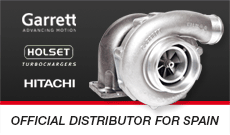FAQ's
- TURBOS - Precisa o turbo dum redutor de aceite?
- TURBOS - ¿Cual es/que causa la holgura axial?
- TURBOS - Quais são os principais problemas para resolver cuando instalam-se turbos instalas turbos?
- RESOLUCÃO DOS PROBLEMAS- Como reconhocer um problema?
- OUTROS - Que é um "exducer"?
- OUTROS - Que é um "inducer"?
Oil requirements depend on the turbo's bearing system type. Garrett has two types of bearing systems; traditional journal bearing; and ball bearing. The journal bearing system in a turbo functions very similarly to the rod or crank bearings in an engine. These bearings require enough oil pressure to keep the components separated by a hydrodynamic film. If the oil pressure is too low, the metal components will come in contact causing premature wear and ultimately failure. If the oil pressure is too high, leakage may occur from the turbocharger seals. With that as background, an oil restrictor is generally not needed for a journal-bearing turbocharger except for those applications with oil-pressure-induced seal leakage. Remember to address all other potential causes of leakage first (e.g., inadequate/improper oil drain out of the turbocharger, excessive crankcase pressure, turbocharger past its useful service life, etc.) and use a restrictor as a last resort. Garrett distributors can tell you the recommended range of acceptable oil pressures for your particular turbo. Restrictor size will always depend on how much oil pressure your engine is generating-there is no single restrictor size suited for all engines. Ball-bearing turbochargers can benefit from the addition of an oil restrictor, as most engines deliver more pressure than a ball bearing turbo requires. The benefit is seen in improved boost response due to less windage of oil in the bearing. In addition, lower oil flow further reduces the risk of oil leakage compared to journal-bearing turbochargers. Oil pressure entering a ball-bearing turbocharger needs to be between 40 psi and 45 psi at the maximum engine operating speed. For many common passenger vehicle engines, this generally translates into a restrictor with a minimum of 0.040" diameter orifice upstream of the oil inlet on the turbocharger center section. Again, it is imperative that the restrictor be sized according to the oil pressure characteristics of the engine to which the turbo is attached. Always verify that the appropriate oil pressure is reaching the turbo. The use of an oil restrictor can (but not always) help ensure that you have the proper oil flow/pressure entering the turbocharger, as well as extract the maximum performance.
turbobygarrett.com
Shaft play is caused by the bearings in the center section of the turbo wearing out over time. When a bearing is worn, shaft play, a side to side wiggling motion of the shaft occurs. This in turn causes the shaft to scrape against the inside of the turbo and often produces a high-pitched whine or whizzing noise. This is a potentially serious condition that can lead to internal damage or complete failure of the turbine wheel or the turbo itself.
turbobygarrett.com
La calibración del motor - fueling and ignition timing. Under boost, it is crucial that there is no engine-killing detonation occurring within the cylinder. This is done by fine tuning the air/fuel ratio a bit rich to help cool the combustion gas, and by tuning the ignition advance curve to ensure that combustion chamber pressures stay below the level that causes unburned fuel to ignite ahead of the advancing flame front.
turbobygarrett.com
Nearly all turbocharger-related problems are the result of a handful of causes. Knowing how to recognize the symptoms of these issues early and link them with causes will help you save (down) time and money.
The chart below outlines the probable causes and noticeable conditions of the most common turbocharger maladies as well as what you can do to solve them.
By using this chart, most turbocharger problems can be easily identified and rectified.
![]() Download the Garrett® Turbocharger Troubleshooting Guide
Download the Garrett® Turbocharger Troubleshooting Guide
turbobygarrett.com
Mirando la rueda compresora desde arriba, el "exducer" es el diámetro mayor de la rueda. Sin embargo en la turbina, el "exducer" es el diámetro menor. El "exducer" en cualquier caso, es por donde el flujo de gases sale. El diámetro del "exducer" de la rueda compresora está incorporado a la nomenclatura de las series GT. El "60" en el modelo GT2860RS por ejemplo, significa que la rueda compresora tiene un diámetro de 60mm.
turbobygarrett.com
Mirando la rueda compresora desde arriba, el "inducer" es el diámetro menor de la rueda. Sim embargo para la turbina, el "inducer" es el diámetro mayor. El "inducer" en cualquier caso es por donde entra el flujo de gases.
turbobygarrett.com








